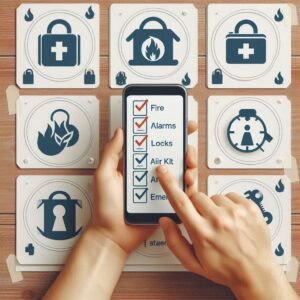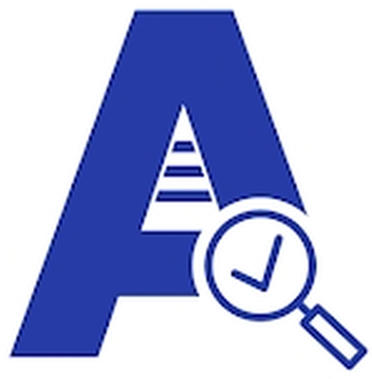Home Safety Checklist
Home Safety Checklist using eAuditor Audits & Inspections involves leveraging the app to ensure a structured, organized, and efficient way to assess and manage home safety risks. eAuditor Audits & Inspections is widely used for inspections, audits, and safety checklists in various industries, but it can also be customized for home use.

Here’s a guide on how to create and implement a Home Safety Checklist in eAuditor Audits & Inspections:
1. Set Up eAuditor Audits & Inspections
- Download eAuditor Audits & Inspections: Install the eAuditor Audits & Inspections app from the App Store or Google Play.
- Create an Account: Sign up or log in if you already have an account.
- Explore Templates: eAuditor Audits & Inspections offers ready-to-use templates. You can search for “Home Safety,” “Fire Safety,” or “Hazard Identification” to find relevant templates.
2. Customize Your Home Safety Checklist Template
- Create a New Template: Start from scratch or customize a pre-existing template to suit your home’s specific needs.
- Organize the Checklist into categories:
- General Safety
- Fire Safety
- Electrical Safety
- Kitchen Safety
- Bathroom Safety
- Living Room Safety
- Outdoor Areas
- Emergency Preparedness
3. Key Elements to Include in Your Home Safety Checklist
a. General Safety
- Are walkways clear of clutter and obstacles?
- Are rugs secured to avoid tripping?
- Is there proper ventilation in all rooms?
- Are stairs well-lit and equipped with sturdy handrails?
- Are smoke detectors functional?
b. Fire Safety
- Are fire extinguishers available and accessible?
- Is there monthly testing in place for smoke alarms?
- Is the kitchen free from fire hazards?
- Are matches, lighters, and flammable materials stored safely?
- Are there clear identifications for escape routes?
c. Electrical Safety
- Are electrical outlets not overloaded?
- Are electrical cords in good condition (no fraying)?
- Is the circuit breaker panel easily accessible?
- Are appliances and electronics switched off when not in use?
- Are extension cords used sparingly and safely?
d. Kitchen Safety
- Are knives and sharp objects stored securely?
- Is there a fire extinguisher in the kitchen?
- Are cleaning products and chemicals stored out of reach of children?
- Is the stove and oven clean to avoid grease fires?
- Are there non-slip mats near sinks to prevent falls?
e. Bathroom Safety
- Are non-slip mats in place inside the bathtub or shower?
- Are electrical appliances (like hair dryers) away from water?
- Is the hot water heater set to a safe temperature (below 120°F)?
- Are cleaning products and medications stored securely?
f. Living Room Safety
- Are furniture edges childproofed if necessary?
- Is there any loose electrical cord running through high-traffic areas?
- Are bookcases and heavy furniture secured to the wall?
- Are television and entertainment systems stable (to avoid tipping)?
g. Outdoor Areas
- Are outdoor lighting and motion sensors functional?
- Are pools or water features secured with fences or covers?
- Is the yard free of debris, like branches or tools?
- Are stairs, walkways, and decks in good condition (no loose boards or railings)?
- Are chemicals, tools, and outdoor equipment stored safely?
h. Emergency Preparedness
- Is there an emergency contact list in a visible place?
- Are family members aware of the fire escape plan?
- Are there flashlights and batteries in case of a power outage?
- Is there an accessible first aid kit?
- Are carbon monoxide detectors functional?
4. Assign Responsibilities
- Delegate Tasks: eAuditor Audits & Inspections allows you to assign tasks to family members (e.g., checking fire extinguishers monthly or testing smoke alarms).
- Set Due Dates: Assign specific deadlines for completing inspections and safety checks.


5. Schedule Regular Inspections
- Automate Reminders: Set up regular reminders within the app to inspect critical areas like fire alarms, carbon monoxide detectors, or emergency supplies.
- Track Completion: Monitor the status of completed and pending tasks, ensuring no checks are missed.
6. Add Photos and Notes
- Visual Evidence: Use eAuditor Audits & Inspection’s feature to take photos of safety issues and attach them directly to your checklist.
- Notes for Follow-up: Add any notes or comments for follow-up action, like calling a technician to inspect an electrical issue.
7. Generate Reports
- Export Reports: Once the inspection is done, generate reports in PDF format and share them with household members.
- Track Progress: Keep a record of past inspections to track improvement or recurring safety hazards.
8. Continuous Improvement
- Modify the Checklist: As your home environment or family dynamics change, update the checklist to address new safety concerns.
- Use Data: eAuditor Audits & Inspections provides analytics on inspections, allowing you to focus on recurring issues or high-risk areas.


By leveraging eAuditor Audits & Inspections for a Home Safety Checklist, you can streamline inspections, assign responsibilities, and ensure your home is safe for all occupants. Regular use will help identify and resolve hazards efficiently, providing peace of mind.
